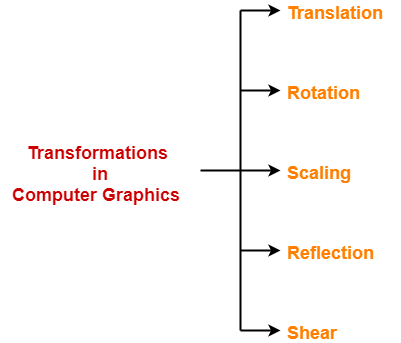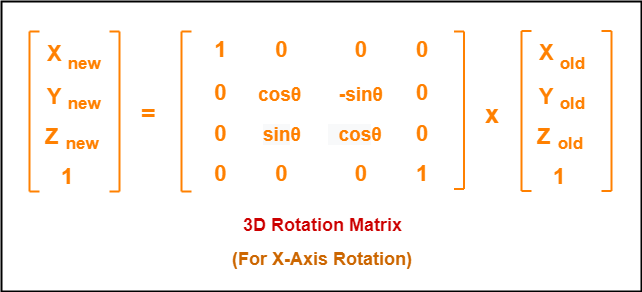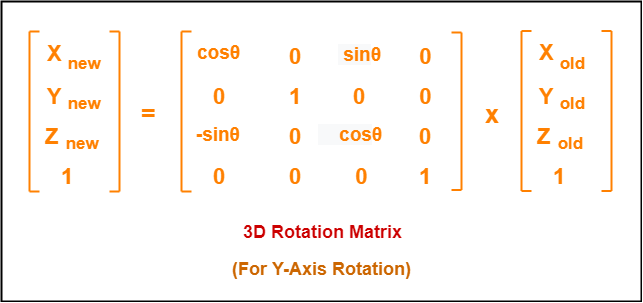3D Transformations in Computer Graphics-
We have discussed-
- Transformation is a process of modifying and re-positioning the existing graphics.
- 3D Transformations take place in a three dimensional plane.
In computer graphics, various transformation techniques are-

In this article, we will discuss about 3D Rotation in Computer Graphics.
3D Rotation in Computer Graphics-
| In Computer graphics,
3D Rotation is a process of rotating an object with respect to an angle in a three dimensional plane. |
Consider a point object O has to be rotated from one angle to another in a 3D plane.
Let-
- Initial coordinates of the object O = (Xold, Yold, Zold)
- Initial angle of the object O with respect to origin = Φ
- Rotation angle = θ
- New coordinates of the object O after rotation = (Xnew, Ynew, Znew)
In 3 dimensions, there are 3 possible types of rotation-
- X-axis Rotation
- Y-axis Rotation
- Z-axis Rotation
For X-Axis Rotation-
This rotation is achieved by using the following rotation equations-
- Xnew = Xold
- Ynew = Yold x cosθ – Zold x sinθ
- Znew = Yold x sinθ + Zold x cosθ
In Matrix form, the above rotation equations may be represented as-

For Y-Axis Rotation-
This rotation is achieved by using the following rotation equations-
- Xnew = Zold x sinθ + Xold x cosθ
- Ynew = Yold
- Znew = Yold x cosθ – Xold x sinθ
In Matrix form, the above rotation equations may be represented as-

For Z-Axis Rotation-
This rotation is achieved by using the following rotation equations-
- Xnew = Xold x cosθ – Yold x sinθ
- Ynew = Xold x sinθ + Yold x cosθ
- Znew = Zold
In Matrix form, the above rotation equations may be represented as-

PRACTICE PROBLEMS BASED ON 3D ROTATION IN COMPUTER GRAPHICS-
Problem-01:
Given a homogeneous point (1, 2, 3). Apply rotation 90 degree towards X, Y and Z axis and find out the new coordinate points.
Solution-
Given-
- Old coordinates = (Xold, Yold, Zold) = (1, 2, 3)
- Rotation angle = θ = 90º
For X-Axis Rotation-
Let the new coordinates after rotation = (Xnew, Ynew, Znew).
Applying the rotation equations, we have-
- Xnew = Xold = 1
- Ynew = Yold x cosθ – Zold x sinθ = 2 x cos90° – 3 x sin90° = 2 x 0 – 3 x 1 = -3
- Znew = Yold x sinθ + Zold x cosθ = 2 x sin90° + 3 x cos90° = 2 x 1 + 3 x 0 = 2
Thus, New coordinates after rotation = (1, -3, 2).
For Y-Axis Rotation-
Let the new coordinates after rotation = (Xnew, Ynew, Znew).
Applying the rotation equations, we have-
- Xnew = Zold x sinθ + Xold x cosθ = 3 x sin90° + 1 x cos90° = 3 x 1 + 1 x 0 = 3
- Ynew = Yold = 2
- Znew = Yold x cosθ – Xold x sinθ = 2 x cos90° – 1 x sin90° = 2 x 0 – 1 x 1 = -1
Thus, New coordinates after rotation = (3, 2, -1).
For Z-Axis Rotation-
Let the new coordinates after rotation = (Xnew, Ynew, Znew).
Applying the rotation equations, we have-
- Xnew = Xold x cosθ – Yold x sinθ = 1 x cos90° – 2 x sin90° = 1 x 0 – 2 x 1 = -2
- Ynew = Xold x sinθ + Yold x cosθ = 1 x sin90° + 2 x cos90° = 1 x 1 + 2 x 0 = 1
- Znew = Zold = 3
Thus, New coordinates after rotation = (-2, 1, 3).
To gain better understanding about 3D Rotation in Computer Graphics,
Next Article- 3D Scaling in Computer Graphics
Get more notes and other study material of Computer Graphics.
Watch video lectures by visiting our YouTube channel LearnVidFun.

